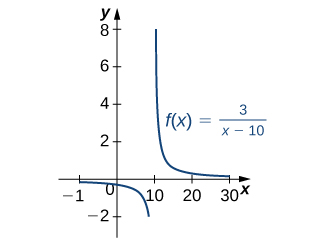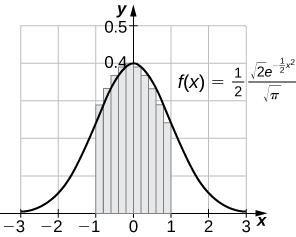Learning Objectives
- Integrate functions involving exponential functions.
- Integrate functions involving logarithmic functions.
Exponential and logarithmic functions are used to model population growth, cell growth, and financial growth, as well as depreciation, radioactive decay, and resource consumption, to name only a few applications. In this section, we explore integration involving exponential and logarithmic functions.
Integrals of Exponential Functions
The exponential function is perhaps the most efficient function in terms of the operations of calculus. The exponential function, [latex]y={e}^{x},[/latex] is its own derivative and its own integral.
Rule: Integrals of Exponential Functions
Exponential functions can be integrated using the following formulas.
Finding an Antiderivative of an Exponential Function
Find the antiderivative of the exponential function [latex]e[/latex]−[latex]x[/latex].
Find the antiderivative of the function using substitution: [latex]{x}^{2}{e}^{-2{x}^{3}}.[/latex]
A common mistake when dealing with exponential expressions is treating the exponent on [latex]e[/latex] the same way we treat exponents in polynomial expressions. We cannot use the power rule for the exponent on [latex]e[/latex]. This can be especially confusing when we have both exponentials and polynomials in the same expression, as in the previous checkpoint. In these cases, we should always double-check to make sure we’re using the right rules for the functions we’re integrating.
Square Root of an Exponential Function
Find the antiderivative of the exponential function [latex]{e}^{x}\sqrt{1+{e}^{x}}.[/latex]
Find the antiderivative of [latex]{e}^{x}{(3{e}^{x}-2)}^{2}.[/latex]
[latex]\int {e}^{x}{(3{e}^{x}-2)}^{2}dx=\frac{1}{9}{(3{e}^{x}-2)}^{3}[/latex]
Hint
Let [latex]u=3{e}^{x}-2u=3{e}^{x}-2.[/latex]
Using Substitution with an Exponential Function
Evaluate the indefinite integral [latex]\int 2{x}^{3}{e}^{{x}^{4}}dx.[/latex]
Hint
Let [latex]u={x}^{4}.[/latex]
As mentioned at the beginning of this section, exponential functions are used in many real-life applications. The number [latex]e[/latex] is often associated with compounded or accelerating growth, as we have seen in earlier sections about the derivative. Although the derivative represents a rate of change or a growth rate, the integral represents the total change or the total growth. Let’s look at an example in which integration of an exponential function solves a common business application.
A price–demand function tells us the relationship between the quantity of a product demanded and the price of the product. In general, price decreases as quantity demanded increases. The marginal price–demand function is the derivative of the price–demand function and it tells us how fast the price changes at a given level of production. These functions are used in business to determine the price–elasticity of demand, and to help companies determine whether changing production levels would be profitable.
Finding a Price–Demand Equation
Find the price–demand equation for a particular brand of toothpaste at a supermarket chain when the demand is 50 tubes per week at $2.35 per tube, given that the marginal price—demand function, [latex]{p}^{\prime }(x),[/latex] for [latex]x[/latex] number of tubes per week, is given as
If the supermarket chain sells 100 tubes per week, what price should it set?
Evaluating a Definite Integral Involving an Exponential Function
Evaluate the definite integral [latex]{\int }_{1}^{2}{e}^{1-x}dx.[/latex]
Evaluate [latex]{\int }_{0}^{2}{e}^{2x}dx.[/latex]
Hint
Let [latex]u=2x.[/latex]
Growth of Bacteria in a Culture
Suppose the rate of growth of bacteria in a Petri dish is given by [latex]q(t)={3}^{t},[/latex] where [latex]t[/latex] is given in hours and [latex]q(t)[/latex] is given in thousands of bacteria per hour. If a culture starts with 10,000 bacteria, find a function [latex]Q(t)[/latex] that gives the number of bacteria in the Petri dish at any time [latex]t[/latex]. How many bacteria are in the dish after 2 hours?
Fruit Fly Population Growth
Suppose a population of fruit flies increases at a rate of [latex]g(t)=2{e}^{0.02t},[/latex] in flies per day. If the initial population of fruit flies is 100 flies, how many flies are in the population after 10 days?
Suppose the rate of growth of the fly population is given by [latex]g(t)={e}^{0.01t},[/latex] and the initial fly population is 100 flies. How many flies are in the population after 15 days?
Hint
Use the process from (Figure) to solve the problem.
Evaluating a Definite Integral Using Substitution
Evaluate the definite integral using substitution: [latex]{\int }_{1}^{2}\frac{{e}^{1\text{/}x}}{{x}^{2}}dx.[/latex]
Evaluate the definite integral using substitution: [latex]{\int }_{1}^{2}\frac{1}{{x}^{3}}{e}^{4{x}^{-2}}dx.[/latex]
Hint
Let [latex]u=4{x}^{-2}.[/latex]
Integrals Involving Logarithmic Functions
Integrating functions of the form [latex]f(x)={x}^{-1}[/latex] result in the absolute value of the natural log function, as shown in the following rule. Integral formulas for other logarithmic functions, such as [latex]f(x)=\text{ln}x[/latex] and [latex]f(x)={\text{log}}_{a}x,[/latex] are also included in the rule.
Rule: Integration Formulas Involving Logarithmic Functions
The following formulas can be used to evaluate integrals involving logarithmic functions.
Finding an Antiderivative Involving [latex]\text{ln}x[/latex]
Find the antiderivative of the function [latex]\frac{3}{x-10}.[/latex]
Find the antiderivative of [latex]\frac{1}{x+2}.[/latex]
Hint
Follow the pattern from (Figure) to solve the problem.
Finding an Antiderivative of a Rational Function
Find the antiderivative of [latex]\frac{2{x}^{3}+3x}{{x}^{4}+3{x}^{2}}.[/latex]
This can be rewritten as [latex]\int (2{x}^{3}+3x){({x}^{4}+3{x}^{2})}^{-1}dx.[/latex] Use substitution. Let [latex]u={x}^{4}+3{x}^{2},[/latex] then [latex]du=4{x}^{3}+6x.[/latex] Alter du by factoring out the 2. Thus,
Rewrite the integrand in [latex]u[/latex]:
Then we have
Finding an Antiderivative of a Logarithmic Function
Find the antiderivative of the log function [latex]{\text{log}}_{2}x.[/latex]
Find the antiderivative of [latex]{\text{log}}_{3}x.[/latex]
Hint
Follow (Figure) and refer to the rule on integration formulas involving logarithmic functions.
(Figure) is a definite integral of a trigonometric function. With trigonometric functions, we often have to apply a trigonometric property or an identity before we can move forward. Finding the right form of the integrand is usually the key to a smooth integration.
Evaluating a Definite Integral
Find the definite integral of [latex]{\int }_{0}^{\pi \text{/}2}\frac{ \sin x}{1+ \cos x}dx.[/latex]
Key Concepts
- Exponential and logarithmic functions arise in many real-world applications, especially those involving growth and decay.
- Substitution is often used to evaluate integrals involving exponential functions or logarithms.
Key Equations
- Integrals of Exponential Functions
[latex]\int {e}^{x}dx={e}^{x}+C[/latex]
[latex]\int {a}^{x}dx=\frac{{a}^{x}}{\text{ln}a}+C[/latex] - Integration Formulas Involving Logarithmic Functions
[latex]\int {x}^{-1}dx=\text{ln}|x|+C[/latex]
[latex]\int \text{ln}xdx=x\text{ln}x-x+C=x(\text{ln}x-1)+C[/latex]
[latex]\int {\text{log}}_{a}xdx=\frac{x}{\text{ln}a}(\text{ln}x-1)+C[/latex]
In the following exercises, compute each indefinite integral.
1. [latex]\int {e}^{2x}dx[/latex]
2. [latex]\int {e}^{-3x}dx[/latex]
3. [latex]\int {2}^{x}dx[/latex]
4. [latex]\int {3}^{\text{−}x}dx[/latex]
5. [latex]\int \frac{1}{2x}dx[/latex]
6. [latex]\int \frac{2}{x}dx[/latex]
7. [latex]\int \frac{1}{{x}^{2}}dx[/latex]
8. [latex]\int \frac{1}{\sqrt{x}}dx[/latex]
In the following exercises, find each indefinite integral by using appropriate substitutions.
9. [latex]\int \frac{\text{ln}x}{x}dx[/latex]
10. [latex]\int \frac{dx}{x{(\text{ln}x)}^{2}}[/latex]
11. [latex]\int \frac{dx}{x\text{ln}x}(x>1)[/latex]
12. [latex]\int \frac{dx}{x\text{ln}x\text{ln}(\text{ln}x)}[/latex]
13. [latex]\int \tan \theta d\theta [/latex]
14. [latex]\int \frac{ \cos x-x \sin x}{x \cos x}dx[/latex]
15. [latex]\int \frac{\text{ln}( \sin x)}{ \tan x}dx[/latex]
16. [latex]\int \text{ln}( \cos x) \tan xdx[/latex]
17. [latex]\int x{e}^{\text{−}{x}^{2}}dx[/latex]
18. [latex]\int {x}^{2}{e}^{\text{−}{x}^{3}}dx[/latex]
19. [latex]\int {e}^{ \sin x} \cos xdx[/latex]
20. [latex]\int {e}^{ \tan x}{ \sec }^{2}xdx[/latex]
21. [latex]\int {e}^{\text{ln}x}\frac{dx}{x}[/latex]
22. [latex]\int \frac{{e}^{\text{ln}(1-t)}}{1-t}dt[/latex]
In the following exercises, verify by differentiation that [latex]\int \text{ln}xdx=x(\text{ln}x-1)+C,[/latex] then use appropriate changes of variables to compute the integral.
23. [latex]\int \text{ln}xdx[/latex][latex](Hint\text{:}\int \text{ln}xdx=\frac{1}{2}\int x\text{ln}({x}^{2})dx)[/latex]
24. [latex]\int {x}^{2}{\text{ln}}^{2}xdx[/latex]
25. [latex]\int \frac{\text{ln}x}{{x}^{2}}dx[/latex][latex](Hint\text{:}\text{Set}u=\frac{1}{x}\text{.})[/latex]
26. [latex]\int \frac{\text{ln}x}{\sqrt{x}}dx[/latex][latex](Hint\text{:}\text{Set}u=\sqrt{x}\text{.})[/latex]
27. Write an integral to express the area under the graph of [latex]y=\frac{1}{t}[/latex] from [latex]t=1[/latex] to ex and evaluate the integral.
28. Write an integral to express the area under the graph of [latex]y={e}^{t}[/latex] between [latex]t=0[/latex] and [latex]t=\text{ln}x,[/latex] and evaluate the integral.
In the following exercises, use appropriate substitutions to express the trigonometric integrals in terms of compositions with logarithms.
29. [latex]\int \tan (2x)dx[/latex]
30. [latex]\int \frac{ \sin (3x)- \cos (3x)}{ \sin (3x)+ \cos (3x)}dx[/latex]
31. [latex]\int \frac{x \sin ({x}^{2})}{ \cos ({x}^{2})}dx[/latex]
32. [latex]\int x \csc ({x}^{2})dx[/latex]
33. [latex]\int \text{ln}( \cos x) \tan xdx[/latex]
34. [latex]\int \text{ln}( \csc x) \cot xdx[/latex]
35. [latex]\int \frac{{e}^{x}-{e}^{\text{−}x}}{{e}^{x}+{e}^{\text{−}x}}dx[/latex]
In the following exercises, evaluate the definite integral.
36. [latex]{\int }_{1}^{2}\frac{1+2x+{x}^{2}}{3x+3{x}^{2}+{x}^{3}}dx[/latex]
37. [latex]{\int }_{0}^{\pi \text{/}4} \tan xdx[/latex]
38. [latex]{\int }_{0}^{\pi \text{/}3}\frac{ \sin x- \cos x}{ \sin x+ \cos x}dx[/latex]
39. [latex]{\int }_{\pi \text{/}6}^{\pi \text{/}2} \csc xdx[/latex]
40. [latex]{\int }_{\pi \text{/}4}^{\pi \text{/}3} \cot xdx[/latex]
In the following exercises, integrate using the indicated substitution.
41. [latex]\int \frac{x}{x-100}dx;u=x-100[/latex]
42. [latex]\int \frac{y-1}{y+1}dy;u=y+1[/latex]
43. [latex]\int \frac{1-{x}^{2}}{3x-{x}^{3}}dx;u=3x-{x}^{3}[/latex]
44. [latex]\int \frac{ \sin x+ \cos x}{ \sin x- \cos x}dx;u= \sin x- \cos x[/latex]
45. [latex]\int {e}^{2x}\sqrt{1-{e}^{2x}}dx;u={e}^{2x}[/latex]
46. [latex]\int \text{ln}(x)\frac{\sqrt{1-{(\text{ln}x)}^{2}}}{x}dx;u=\text{ln}x[/latex]
In the following exercises, does the right-endpoint approximation overestimate or underestimate the exact area? Calculate the right endpoint estimate R50 and solve for the exact area.
47. [T][latex]y={e}^{x}[/latex] over [latex]\left[0,1\right][/latex]
48. [T][latex]y={e}^{\text{−}x}[/latex] over [latex]\left[0,1\right][/latex]
49. [T][latex]y=\text{ln}(x)[/latex] over [latex]\left[1,2\right][/latex]
50. [T][latex]y=\frac{x+1}{{x}^{2}+2x+6}[/latex] over [latex]\left[0,1\right][/latex]
51. [T][latex]y={2}^{x}[/latex] over [latex]\left[-1,0\right][/latex]
52. [T][latex]y=\text{−}{2}^{\text{−}x}[/latex] over [latex]\left[0,1\right][/latex]
In the following exercises, [latex]f(x)\ge 0[/latex] for [latex]a\le x\le b.[/latex] Find the area under the graph of [latex]f(x)[/latex] between the given values [latex]a[/latex] and [latex]b[/latex] by integrating.
53. [latex]f(x)=\frac{{\text{log}}_{10}(x)}{x};a=10,b=100[/latex]
54. [latex]f(x)=\frac{{\text{log}}_{2}(x)}{x};a=32,b=64[/latex]
55. [latex]f(x)={2}^{\text{−}x};a=1,b=2[/latex]
56. [latex]f(x)={2}^{\text{−}x};a=3,b=4[/latex]
57. Find the area under the graph of the function [latex]f(x)=x{e}^{\text{−}{x}^{2}}[/latex] between [latex]x=0[/latex] and [latex]x=5.[/latex]
58. Compute the integral of [latex]f(x)=x{e}^{\text{−}{x}^{2}}[/latex] and find the smallest value of N such that the area under the graph [latex]f(x)=x{e}^{\text{−}{x}^{2}}[/latex] between [latex]x=N[/latex] and [latex]x=N+10[/latex] is, at most, 0.01.
59. Find the limit, as N tends to infinity, of the area under the graph of [latex]f(x)=x{e}^{\text{−}{x}^{2}}[/latex] between [latex]x=0[/latex] and [latex]x=5.[/latex]
60. Show that [latex]{\int }_{a}^{b}\frac{dt}{t}={\int }_{1\text{/}b}^{1\text{/}a}\frac{dt}{t}[/latex] when [latex]0<a\le b.[/latex]
61. Suppose that [latex]f(x)>0[/latex] for all [latex]x[/latex] and that [latex]f[/latex] and [latex]g[/latex] are differentiable. Use the identity [latex]{f}^{g}={e}^{g\text{ln}f}[/latex] and the chain rule to find the derivative of [latex]{f}^{g}.[/latex]
62. Use the previous exercise to find the antiderivative of [latex]h(x)={x}^{x}(1+\text{ln}x)[/latex] and evaluate [latex]{\int }_{2}^{3}{x}^{x}(1+\text{ln}x)dx.[/latex]
63. Show that if [latex]c>0,[/latex] then the integral of [latex]1\text{/}x[/latex] from ac to bc [latex](0<a<b)[/latex] is the same as the integral of [latex]1\text{/}x[/latex] from [latex]a[/latex] to [latex]b[/latex].
The following exercises are intended to derive the fundamental properties of the natural log starting from the Definition/em> [latex]\text{ln}(x)={\int }_{1}^{x}\frac{dt}{t},[/latex] using properties of the definite integral and making no further assumptions.
64. Use the identity [latex]\text{ln}(x)={\int }_{1}^{x}\frac{dt}{t}[/latex] to derive the identity [latex]\text{ln}(\frac{1}{x})=\text{−}\text{ln}x.[/latex]
65. Use a change of variable in the integral [latex]{\int }_{1}^{xy}\frac{1}{t}dt[/latex] to show that [latex]\text{ln}xy=\text{ln}x+\text{ln}y\text{ for }x,y>0.[/latex]
66. Use the identity [latex]\text{ln}x={\int }_{1}^{x}\frac{dt}{x}[/latex] to show that [latex]\text{ln}(x)[/latex] is an increasing function of [latex]x[/latex] on [latex][0,\infty )[/latex] and use the previous exercises to show that the range of [latex]\text{ln}(x)[/latex] is [latex](\text{−}\infty ,\infty ).[/latex] Without any further assumptions, conclude that [latex]\text{ln}(x)[/latex] has an inverse function defined on [latex](\text{−}\infty ,\infty ).[/latex]
67. Pretend, for the moment, that we do not know that [latex]{e}^{x}[/latex] is the inverse function of [latex]\text{ln}(x),[/latex] but keep in mind that [latex]\text{ln}(x)[/latex] has an inverse function defined on [latex](\text{−}\infty ,\infty ).[/latex] Call it E. Use the identity [latex]\text{ln}xy=\text{ln}x+\text{ln}y[/latex] to deduce that [latex]E(a+b)=E(a)E(b)[/latex] for any real numbers [latex]a[/latex], [latex]b[/latex].
68. Pretend, for the moment, that we do not know that [latex]{e}^{x}[/latex] is the inverse function of [latex]\text{ln}x,[/latex] but keep in mind that [latex]\text{ln}x[/latex] has an inverse function defined on [latex](\text{−}\infty ,\infty ).[/latex] Call it E. Show that [latex]E\text{‘}(t)=E(t).[/latex]
69. The sine integral, defined as [latex]S(x)={\int }_{0}^{x}\frac{ \sin t}{t}dt[/latex] is an important quantity in engineering. Although it does not have a simple closed formula, it is possible to estimate its behavior for large [latex]x[/latex]. Show that for [latex]k\ge 1,|S(2\pi k)-S(2\pi (k+1))|\le \frac{1}{k(2k+1)\pi }.[/latex](Hint: [latex]\sin (t+\pi )=\text{−} \sin t[/latex])
70. [T] The normal distribution in probability is given by [latex]p(x)=\frac{1}{\sigma \sqrt{2\pi }}{e}^{\text{−}{(x-\mu )}^{2}\text{/}2{\sigma }^{2}},[/latex] where σ is the standard deviation and μ is the average. The standard normal distribution in probability, [latex]{p}_{s},[/latex] corresponds to [latex]\mu =0\text{ and }\sigma =1.[/latex] Compute the left endpoint estimates [latex]{R}_{10}\text{ and }{R}_{100}[/latex] of [latex]{\int }_{-1}^{1}\frac{1}{\sqrt{2\pi }}{e}^{\text{−}{x}^{2\text{/}2}}dx.[/latex]
71. [T] Compute the right endpoint estimates [latex]{R}_{50}\text{ and }{R}_{100}[/latex] of [latex]{\int }_{-3}^{5}\frac{1}{2\sqrt{2\pi }}{e}^{\text{−}{(x-1)}^{2}\text{/}8}.[/latex]
![A graph of the function f(x) = e^x * sqrt(1 + e^x), which is an increasing concave up curve, over [-3, 1]. It begins close to the x axis in quadrant two, crosses the y axis at (0, sqrt(2)), and continues to increase rapidly.](https://s3-us-west-2.amazonaws.com/courses-images/wp-content/uploads/sites/2332/2018/01/11204252/CNX_Calc_Figure_05_06_001.jpg)
![A graph of the function f(x) = e^(1-x) over [0, 3]. It crosses the y axis at (0, e) as a decreasing concave up curve and symptotically approaches 0 as x goes to infinity.](https://s3-us-west-2.amazonaws.com/courses-images/wp-content/uploads/sites/2332/2018/01/11204254/CNX_Calc_Figure_05_06_002.jpg)



Hint
Let [latex]u[/latex] equal the exponent on [latex]e[/latex].